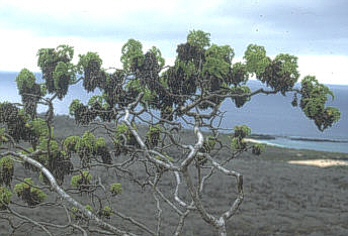FLORA of SAN CRISTOBAL
The
Galapagos archipleago is home to about 250 endemic species,
about
half of all those living on the islands. San Cristobal has
especially dense vegetation on its southern end, and an abundance of
species around it's Junco Lagoon, the only freshwater body on the
islands. There are several plants which are endemic to San
Cristobal only, and a few which live on only 2 or 3 of the
islands. These include:
Salt
Bushes
Spiny
Shrubs
Palo
Santo
Muyuyos
Tree
Yellow-Green
Shrubs
Sesuvium

Scalesia © Peter v.
Sengbusch - b-online@botanik.uni-hamburg.de
There
are many species of plants which are characteristic of the
Galapagos which live in great numbers on San Cristobal. The most
famous of these are the Scalesia tree, the "daisy tree", the miconia,
used in coffee production, the lava cactus, prickly pear cacti, and
giant ferns.
Blackberry
bushes are an introduced species which is of great concern
becuase they tend to take over.
On
San Cristobal there are several very distinct growth zones.
The lowest, the Arid Zone, is desertlike and home to the largest number
of species on the island, including many types of deciduous tree and
other plants adapted to drought, like cacti. The Transition Zone,
the next up, is, as you might expect, more difficult to
characterize. Following the Transition Zone is the Scalesia Zone,
a cloudy forest filled with the endemic Scalesia tree and other
evergreens. Next is the Brown Zone, another transition zone, full
of trees draped with lichens, mosses and ferns. The Miconia Zone,
present only on San Cristobal and to a lesser extent on Santa Cruz, is
the next area, densely covered in Miconia shrubs. The last zone,
the Pampa Zone, occurs only on a few islands. San Cristobal's
Pampa zone is above the tree line for that part of the world at about
4000 feet elevation. It is very wet and grasses and sedges grow
there.


